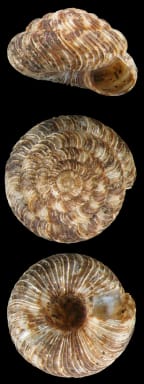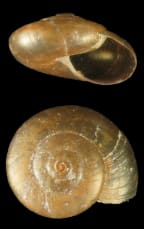By Alison Ballance
Here’s a little known but incredible fact about New Zealand’s biodiversity: we have more species of land snails for our area than any other temperate country.

Land snails collected from Khandallah Park included species such as (left to right): Cavellia anguicula, Laoma mariae, Mocella eta and Phenacharopa novoseelandica Photo: David Roscoe / Department of Conservation

The small land snail Charopa coma is one of the commonest land snails, found in forest throughout New Zealand. Photo: David Roscoe / Department of Conservation
It’s hard to get an exact number because most of our land snails are minute, only 60-70%of species collected to date have been described, and almost every time someone looks in a new place they find new species. So that gives us a conservative estimate of about 1400 species – and some experts reckon we’ll end up with more than 2000.
Of course there are the famous giant land snails: the 70-or-so species and sub-species of Powelliphanta. Their shells can be up to 9 cm across, they have beautifully patterned shells, and they hunt earthworms.
Then there are the large Placostylus flax snails from Northland; these gentle vegetarians never stray far, and are getting a hard time from introduced rats and pigs.
But by far the bulk of our land snails are tiny species that live in rotting leaf litter. A large micro land snail might be 4-5 mm across, and many of them are less than a millimetre. They’re not exactly something you’ll stumble across accidentally, but if you make the effort to look through some leaf litter under a big magnifying glass, and then pop one of these little beauties under a microscope, you’ll discover they are the most extraordinary mini-sculptures.
I joined expert Phil Parkinson on land snail hunt in Khandallah Park in Wellington. He was after a particular species called Flammulina compressivoluta, which has been recorded from the park. At nearly 8 mm across it’s a macro-sized micro land snail, and Phil is keen to collect some specimens for genetic analysis. Most of the land snail taxonomy done to date is based on traditional morphology, usually of the shell, and genetic analysis is the next logical step, which may help resolve some of the questions currently hanging over some identifications.
Phil demonstrated how he collects leaf litter, using progressively smaller sieves to concentrate the fraction of decomposing leaf litter that lies above the soil and below freshly fallen leaves.

These three snails are all in the genus Cavellia and are all found in Wellington: (left to right) Cavellia brouni, C. buccinella and C. serpentinula. Photo: David Roscoe / Department of Conservation

Side view and top view of the land snail Flammulina compressivoluta, which has a shell about 8mm across. Photo: David Roscoe / Department of Conservation
Back at home Phil patiently sorts through the bags of leaf litter, picking out land snails that may be as small as 0.7 mm, and then using a microscope to identify them from their shells. Most New Zealand land snails come from just two families – the Punctidae and the Charopidae – but there is an extraordinary diversity of them at the genus and species level. More than a third of them have not yet been described. As a result many of them go by names such as Punctidae sp.199 (meaning it’s the 199th undescribed Punctid!).
Our collecting trip to Khandallah Park failed to turn up any Flammulina compressivoluta, but from the nearly 200 specimens he counted Phil identified 22 different species. Phil considered this to be on the low side, probably because the weather had been very dry for the preceding weeks.
Phil has carried out very systematic surveys of three different reserves in Wellington and has identified the land snail fauna at those sites: about 50 species from Zealandia sanctuary, more than 60 species from Otari-Wilton Bush and over 70 from the Eastbourne Hills.
After joining Phil in the field, I called in on another snail expert, David Roscoe, who is spending his retirement at the Department of Conservation, taking detailed photos of the micro land snails. The plan is that these photos will eventually be used to illustrate a land snail atlas for New Zealand – there is currently no comprehensive field guide to New Zealand land snails although Landcare Research has a small online key to two genera, Cytora and Allodiscus.
David takes up to a 100 images and stacks them up to create the detailed images, such as the ones you can see on this web page. He says that ‘where most countries have 5-7 species in a forest patch, we average 30! The richest spots known worldwide are Waiuku, near Auckland, that has 95 species, and the Wainuiomata Waterworks Reserve near Wellington that has 88 species – so far.”

A selection of New Zealand land snails, showing a variety of patterns and shapes. From left to right, Phenacohelix lucetta, Tubuaia novoseelandica and Wainuia urnula, which is one of our largest land snails. It can be 2-3 cm across, and hunts amphipods. Photo: David Roscoe / Department of Conservation

